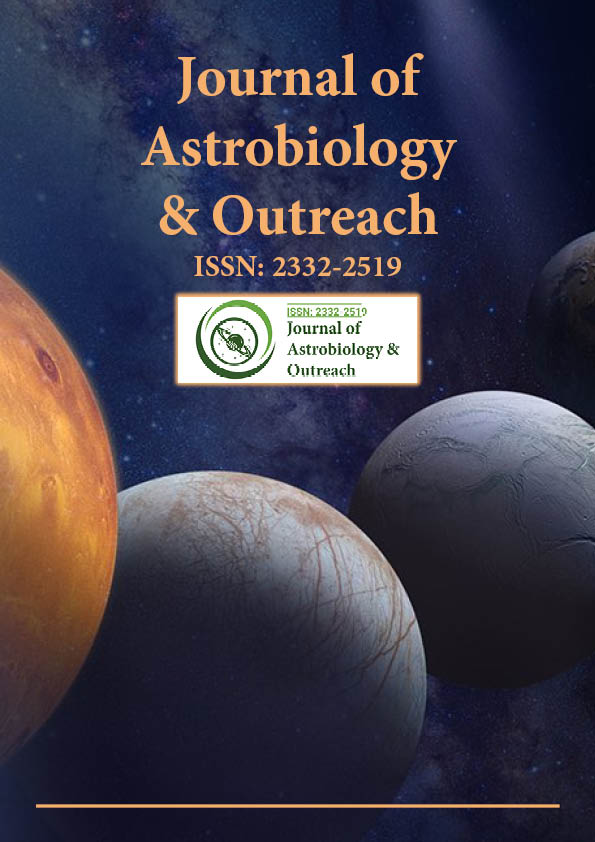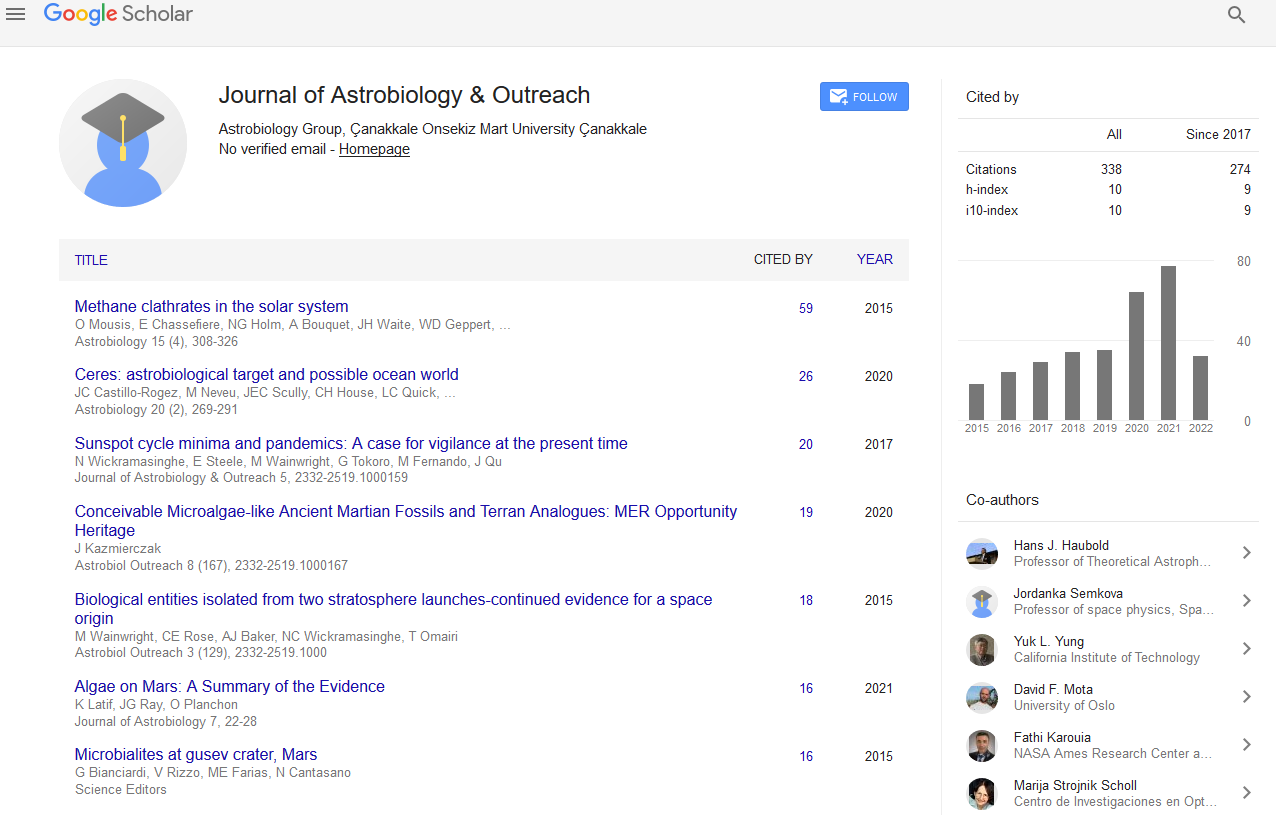Indexed In
- Open J Gate
- Academic Keys
- JournalTOCs
- RefSeek
- Hamdard University
- EBSCO A-Z
- OCLC- WorldCat
- Google Scholar
Useful Links
Share This Page
Journal Flyer

Open Access Journals
- Agri and Aquaculture
- Biochemistry
- Bioinformatics & Systems Biology
- Business & Management
- Chemistry
- Clinical Sciences
- Engineering
- Food & Nutrition
- General Science
- Genetics & Molecular Biology
- Immunology & Microbiology
- Medical Sciences
- Neuroscience & Psychology
- Nursing & Health Care
- Pharmaceutical Sciences
Commentary - (2024) Volume 12, Issue 2
Signals beyond Sight: The Impact of Spectral-Domain Radio Astronomy
Holter Brunet*Received: 28-May-2024, Manuscript No. JAO-24-27363; Editor assigned: 31-May-2024, Pre QC No. JAO-24-27363 (PQ); Reviewed: 14-Jun-2024, QC No. JAO-24-27363; Revised: 21-Jun-2024, Manuscript No. JAO-24-27363 (R); Published: 28-Jun-2024, DOI: 10.35248/2332-2519.24.12.342
Description
Spectral-domain radio astronomy is a unique field focused on collecting and analyzing data from the radio spectrum to study celestial objects. Unlike optical astronomy, which relies on visible light, radio astronomy uses radio waves to observe the universe, providing insight into phenomena invisible to optical telescopes. This approach allows scientists to analyze a wide range of cosmic features, from stars and planets to galaxies and interstellar clouds, revealing valuable information about their properties, behavior and structure. In radio astronomy, spectral data is collected through highly sensitive instruments that can detect faint signals from distant objects. Each radio wave frequency corresponds to specific characteristics of an object and analyzing these frequencies reveals the chemical composition, temperature, density and velocity of objects in space. For example, particular wavelengths may indicate the presence of elements like hydrogen or molecules such as carbon monoxide, which can help to learn more about the origins and evolution of galaxies and stars.
To gather spectral-domain radio data, radio telescopes are used. These instruments are often configured into large arrays to capture and amplify weak signals. Arrays like the Very Large Array (VLA) or the Atacama Large Millimeter/Submillimeter Array (ALMA) combine signals from multiple antennas to increase resolution, allowing for detailed examination of objects in the sky. By coordinating many antennas, scientists can capture more precise data, providing a clearer view of the complex structures and interactions between celestial bodies. One of the key advantages of radio astronomy is its ability to observe regions obscured by dust clouds that block other forms of electromagnetic radiation, like visible light. This capability is essential for studying regions where stars form, as these areas are often hidden from optical telescopes. Because radio waves can penetrate these clouds, radio astronomers can investigate the inner workings of star-forming regions, galaxy evolution and planetary system dynamics. By studying these previously unreachable areas, radio astronomy provides a window into the processes shaping galaxies and stars.
In the spectral domain, each frequency reveals distinct information about the objects being studied. Different elements and molecules absorb and emit radio waves at specific frequencies, which is the basis of spectral-line studies. By observing these frequencies, astronomers can identify particular substances in space. For example, hydrogen, the most abundant element in the universe, emits a unique signal at a wavelength of 21 cm in the radio spectrum. By mapping hydrogen distribution, scientists gain insights into the structure and growth of galaxies. Beyond individual elements, spectral-domain radio astronomy plays a essential role in observing molecular clouds massive formations of gas and dust where new stars are born. By studying these emissions, astronomers can determine factors such as temperature, density and cloud composition. This information provides insights into the conditions needed for star formation and helps explain the role of molecular clouds in the life cycles of galaxies.
Spectral-domain radio data also enables the study of object motion in space through the Doppler Effect, which describes how a wave’s frequency shifts as the source moves relative to an observer. When a star or galaxy moves towards Earth, its radio waves compress to higher frequencies; if it’s moving away, they stretch to lower values. This data on velocity allows scientists to track galaxy movement, measure galaxy rotation and estimate the universe's expansion rate, adding to our understanding of cosmic structure and interactions. Another application of spectral-domain radio astronomy lies in studying the Cosmic Microwave Background (CMB), the faint radiation left over from the Big Bang. The CMB fills the universe with a glow of radio waves and offers a glimpse into its infancy, around 380,000 years after its formation. By analyzing the CMB's spectral characteristics, scientists learn about early universe conditions, the formation of the first atoms and the development of cosmic structures, contributing significantly to cosmology. Processing and interpreting spectral-domain radio data requires advanced techniques and computational tools. Radio signals are often faint and can be impacted by interference from Earth-based sources. Filtering and cleaning data is essential to ensure accuracy. Modern observatories utilize complex algorithms and processing pipelines to handle the massive data volumes collected by radio telescopes. This data is then analyzed with software that distinguishes subtle spectral features, which indicate different molecules or elements, revealing otherwise hidden cosmic details. As technology advances, the capacity of spectral-domain radio astronomy continues to grow, allowing for deeper exploration of the cosmos. With newer, more powerful radio telescopes being developed, scientists are set to explore regions of space previously beyond reach. These advancements are expected to improve observation resolution and sensitivity, helping scientists to probe cosmic mysteries at unprecedented scales. With these expanding capabilities, spectral-domain radio astronomy continues to play a significant role in humanity’s exploration and understanding of the universe.
Citation: Brunet H (2024). Signals beyond Sight: The Impact of Spectral-Domain Radio Astronomy. J Astrobiol Outreach. 12:342.
Copyright: © 2024 Brunet H. This is an open-access article distributed under the terms of the Creative Commons Attribution License, which permits unrestricted use, distribution, and reproduction in any medium, provided the original author and source are credited.

